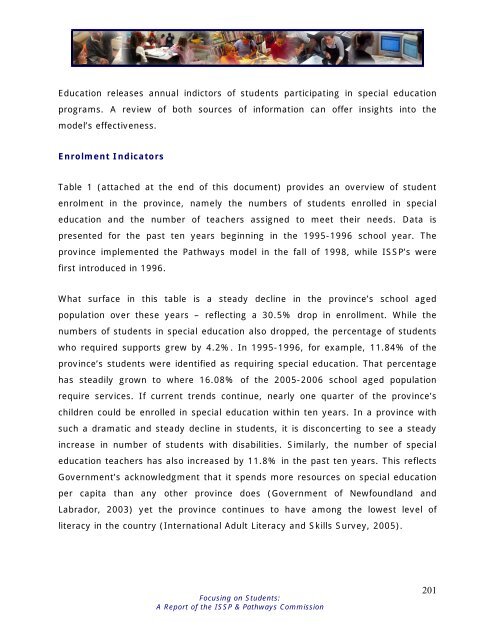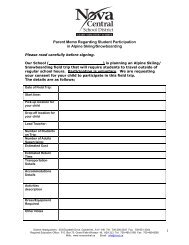- Page 2 and 3:
Government of Newfoundland and Labr
- Page 4 and 5:
Bernice LangdonCommissionerBill Som
- Page 6 and 7:
3.11. “At-risk” students 653.12
- Page 8 and 9:
een developed and implemented withi
- Page 10 and 11:
AcknowledgementsThe Commission woul
- Page 12 and 13:
These recommendations evolved direc
- Page 14 and 15:
of Education pursue certain recomme
- Page 16 and 17:
1.3 Advisory CommitteeAn advisory c
- Page 19 and 20:
Principle 4:The Commission’s data
- Page 21 and 22:
An exceptionally high rate of retur
- Page 23 and 24:
• The current model focuses on de
- Page 25 and 26:
design and structure of curriculum.
- Page 27 and 28:
Services to Children and Youth. As
- Page 29 and 30:
When a child/youth is identified as
- Page 31 and 32:
• Pathway Two: The provincially p
- Page 33 and 34:
3.0 Key Findings and Recommendation
- Page 35 and 36:
The Commission notes that the Labra
- Page 37 and 38:
Therefore, the Commission recommend
- Page 39 and 40:
3.3 Educational Record-keepingThis
- Page 41 and 42:
Table 3:Provincial distribution of
- Page 43 and 44:
Given earlier findings on the accur
- Page 45 and 46:
Table 6: Provincial distribution of
- Page 47 and 48:
out of the system. One area of part
- Page 49 and 50:
• Where there is more than one pr
- Page 51 and 52:
Adding to this frustration is recog
- Page 53 and 54:
Table 10: Communications regarding
- Page 55 and 56:
Recommendation 10the department hea
- Page 57 and 58:
Recommendation 13the Department of
- Page 59 and 60:
3.9 Behavioural analysis and suppor
- Page 61 and 62:
Even a cursory glance at the litera
- Page 63 and 64:
assessments. It indicates that 44.3
- Page 65 and 66:
Recommendation 21the Department of
- Page 67 and 68:
Recommendation 27the Department of
- Page 69 and 70:
A pan-Canadian review revealed that
- Page 71 and 72:
Table 14: Exceptionally Able Learne
- Page 73 and 74:
Nova Scotia articulates its approac
- Page 75 and 76:
increased emphasis on mathematics a
- Page 77 and 78:
The Commission’s pan-Canadian rev
- Page 79 and 80:
French being the dominant language
- Page 81 and 82:
Manitoba Education has a similar ap
- Page 83 and 84:
3.16 Support for ParentsThe Commiss
- Page 85 and 86:
Table 15:Numbers of parents who rec
- Page 87 and 88:
parents. Jurisdictions are increasi
- Page 90 and 91:
Concern for the absence of an effec
- Page 92 and 93:
3.18.2 Teacher AssistantsCurrently
- Page 94 and 95:
assistants (job titles vary among p
- Page 96 and 97:
Recommendation 54the Department of
- Page 98:
Table 17: Attitudes of classroom te
- Page 101 and 102:
equivalent certification (italics a
- Page 103:
Table 20: Academic Qualifications:P
- Page 106 and 107:
While implementing these recommenda
- Page 108 and 109:
In this light, and combined with pr
- Page 111 and 112:
Table 23: Guidance counsellorsRespo
- Page 113 and 114:
3.19 Professional DevelopmentGiven
- Page 115:
Table 25: Teachers-identified in-se
- Page 118 and 119:
Recommendation 74regular “refresh
- Page 120 and 121:
too many parents and educators alik
- Page 122 and 123:
and continued reason for NL to rema
- Page 124 and 125:
Government of Manitoba (2004). Work
- Page 126 and 127:
Roberts, C. and Lazure, M. (1970).
- Page 128 and 129:
Recommendation 9the department head
- Page 130 and 131:
Recommendation 26the Department of
- Page 132 and 133:
Recommendation 43the Department of
- Page 134 and 135:
Recommendation 58the Department of
- Page 136 and 137:
needs related to the Model for the
- Page 138 and 139:
Newfoundland and LabradorAssociatio
- Page 140 and 141:
Visit to Labrador DistrictNovember
- Page 142 and 143:
Visit to Eastern DistrictNovember 1
- Page 144 and 145:
Visit to Conseil Scolaire Francopho
- Page 146 and 147:
Table 1: The Stratified SampleSchoo
- Page 148 and 149:
Table 2: Response RateStatus Freque
- Page 150 and 151:
Data AnalysisAt the completion of t
- Page 152 and 153: TEACHER SURVEYSection 1(To be compl
- Page 154 and 155: 5. (a) Please indicate the number o
- Page 156 and 157: 8. (c) Please indicate the average
- Page 158 and 159: 16. On average, how long are you wa
- Page 160 and 161: 33. Some students are “falling th
- Page 162 and 163: 54. Speech Language Pathologists as
- Page 164 and 165: APPENDIX E:List of SubmissionsAnder
- Page 166 and 167: Langdon, TrentBishop, DavidNewfound
- Page 168 and 169: APPENDIX F:Key InformantsAnthony, J
- Page 170 and 171: Ferguson, TammyFerris, MaryFitzpatr
- Page 172 and 173: Humphries, AnneKean-Dobbin, Claudin
- Page 174 and 175: Palmer, Dr. BarbaraParsons, RobertP
- Page 176 and 177: Sarkany-Coles, GailSheppard, FaronS
- Page 178 and 179: White, PerryWindeler, HenryPrincipa
- Page 180 and 181: Evolution of special educationA rev
- Page 182 and 183: out of this report that would go on
- Page 184 and 185: In the early 1970’s, this parenta
- Page 186 and 187: with provisions for joint planning,
- Page 188 and 189: attended to in separate classrooms
- Page 190 and 191: against the parents of the rest of
- Page 192 and 193: ising wind of change that would swe
- Page 194 and 195: done. The curriculum guides outline
- Page 196 and 197: education and bridging “the divid
- Page 198 and 199: where the benefits will extend to a
- Page 200 and 201: egular classroom when the choice cl
- Page 204 and 205: Tables 2 & 3 (see end of this docum
- Page 206 and 207: knowledge as to their needs. Subseq
- Page 208 and 209: a lack of practical supports in the
- Page 210 and 211: and resulting frustration among all
- Page 212 and 213: negate blame and validate the strug
- Page 214 and 215: Table 1: Enrolment and Teacher Allo
- Page 216 and 217: Table 3: Categorical AllocationsExc
- Page 218 and 219: graduation: A handbook for all teac
- Page 220 and 221: Maich, K. (2002). When pathways cro
- Page 222 and 223: Skrtic, T. M. (1995). The special e
- Page 224 and 225: APPENDIX H:Inter-Ministerial Protoc
- Page 226 and 227: 4. Services should be organized to
- Page 228 and 229: - Support ongoing professional deve
- Page 230 and 231: 2. The ISSP is a process with a pre
- Page 232 and 233: . child's level of development indi
- Page 234 and 235: 13. The ISSP Manager will be respon
- Page 236 and 237: Appendix J:Child Youth ProfilesMode
- Page 238 and 239: CategoryPhysicalNeed (check allappl
- Page 240 and 241: CategoryTechnologyProgramNeed (chec













